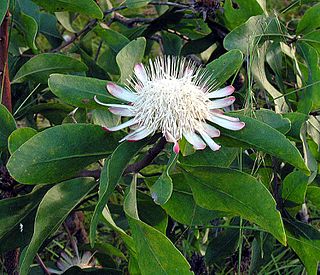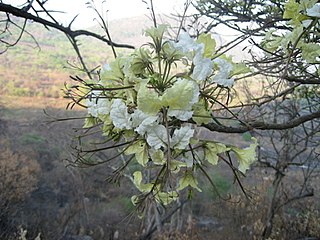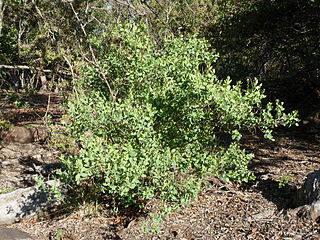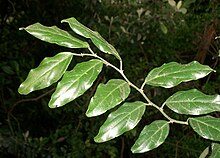
Protea gaguedi is a species of tree which belongs to the genus Protea.

Protea welwitschii is a species of shrub or small tree which belongs to the genus Protea, and which occurs in bushveld and different types of grassland.

The Barberton groundsel or succulent bush senecio is an evergreen succulent shrub of the family Asteraceae and genus Senecio, native to Southern Africa, named after one of its native localities Barberton and is now also being cultivated elsewhere for its drought resistance, clusters of sweetly scented, golden-yellow, tufted flower heads in winter and attractiveness to butterflies, the painted lady butterfly in particular.

Capparis is a flowering plant genus, comprising around 250 species in the family Capparaceae which is included in the Brassicaceae in the unrevised APG II system. These plants are shrubs or lianas and are collectively known as caper shrubs or caperbushes. Capparis species occur over a wide range of habitat in the subtropical and tropical zones.

Galactia is a genus of plants in the legume family (Fabaceae). It belongs to the subfamily Faboideae. They do not have an unambiguous common name, being commonly called milk peas, beach peas or wild peas.

Sevenia boisduvali, the Boisduval's tree nymph, is a butterfly in the family Nymphalidae. There are four subspecies; all native to Africa.

Dixeia pigea, the ant-heap small white or ant-heap white, is a butterfly in the family Pieridae that is native to Africa.

Capparis tomentosa, the woolly caper bush or African caper, is a plant in the Capparaceae family and is native to Africa.

Croton gratissimus, is a tropical African shrub or small tree with corky bark, growing to 8 m and belonging to the family of Euphorbiaceae or spurges. Young twigs are slender and angular and covered in silver and rust-coloured scales.

Cladostemon kirkii, commonly known as the three-finger bush, is a small deciduous tree belonging to the Capparaceae or caper family. It is a genus that has only this one species (monotypic). It is distributed through Kenya, Tanzania, Malawi, Mozambique, Zambia, Zimbabwe, Eswatini and KwaZulu-Natal in Southern Africa.

Erianthemum dregei is a species of parasitic plant in the family Loranthaceae, and is commonly known as the hairy mistletoe or wood flower.

Clutia pulchella, the lightning bush, is a southern African dioecious shrub of the family Peraceae. It occurs at middle altitudes in Namibia, Mozambique, Zimbabwe, Eswatini, Botswana, Lesotho and South Africa.

Maerua cafra (DC.) Pax is a small Southern African tree belonging to Capparaceae, the caper family, occurring eastwards along the coast from Knysna, then further inland and northwards through KwaZulu-Natal and Eswatini to the Transvaal, southern Mozambique and southern Zimbabwe. The genus Maerua comprises about 60 species found in Africa and Asia.

Jamesbrittenia ramosissima is a Southern African shrub in the family Scrophulariaceae occurring in the Northern Cape and southern Namibia, westward along the Gariep River from the vicinity of Augrabies Falls. It is one of some 90 species in the genus Jamesbrittenia, ranging through Africa, with 74 species occurring in Southern Africa, and 1 in India. The genus is named for James Britten (1846-1924), medical student turned botanist, and acting Keeper of Botany at the British Museum when Kuntze named it.

Hymenodictyon parvifolium Oliv. is a small rubiaceous African tree and is one of some 24 species in the genus, with a tropical African and Asian distribution. This species grows as a small tree to some 5 metres tall, or sometimes a liane or scrambler to 10.5 m, and is found in low-altitude woodland.

Boscia foetida, commonly known as the stink shepherd's tree and the smelly shepherd's bush, is an evergreen shrub or tree that is native to the warmer and drier parts southern Africa. It is found in semi-desert and arid bushveld, and in the west it occurs commonly in areas which are otherwise sparsely wooded. It is known for the particularly unpleasant smell of its flowers which appear during early spring, to which its specific name foetida alludes. Its freshly cut wood likewise has an unpleasant smell, and has traditional medicinal and magical uses, for instance as a protection against lightning. In central Botswana the village of Mopipi is named after this species.
Vachellia kirkii, widely known as Acacia kirkii but now attributed to the genus Vachellia, is a tree native to tropical Africa. It is commonly known as the flood plain acacia.
Protea asymmetrica, also known as the Inyanga sugarbush, is a flowering plant, named for its asymmetric flowerheads, of the family Proteaceae and endemic to Zimbabwe and the Nyanga region, where it grows in grasslands, as well as Mount Nyangani.






















